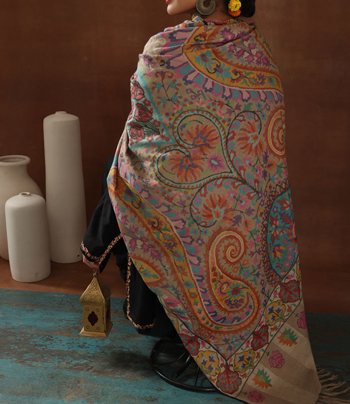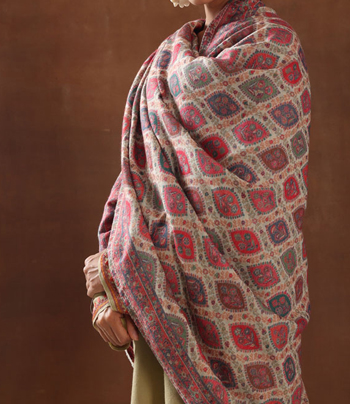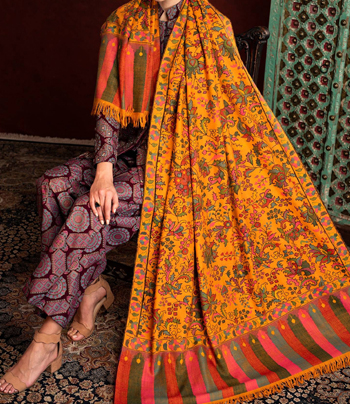Kashmir Pashmina
Pashmina was first made by the inhabitants of Kashmir. The quest for making a fine warm fabric that can protect them from the atrocious weather in severe winters created Pashmina when the inhabitants of Kashmir discovered an animal that produced one of the warmest raw materials called Pashm.
Himalayan farmers climb the high altitude pastures of Western Himalayas, including the contiguous South Eastern Ladakh with an altitude of above 4500 metres (14500 feet) with harshly wind swept terrain and winter temperatures that falls as low as minus 30 degrees centigrade to comb fine woollen undercoat from the neck and belly of the Capra Hiracus or Pashmina goat, as it is popularly known. The fleece obtained is very fine on the inside and gradually becomes coarse on the outside. Pashm has a special lustre due to its long, fine fibres, which are as thin as 12-16 microns, the fibres from premium sheep’s wool, such as Merino extra fine are 23 micron thick, while a human hair ranges up to 200 Microns thickness. Thus Pashmina is exceptionally light, soft and warm and feels luxurious against the skin. The natural colour of the fleece ranges from white to grey, red, brown and black. Pashmina is the woven form of Pashm. It is made in 3 qualities which are largely assessed on the fineness of the yarn and the tension of the weave. During the weaving process the fabric is woven in three basic weaves, which are; 1. Twill or Sade Bunai 2. Diamond or Chashm-e-Bulbul Bunai 3. Herringbone or Gada Kond Bunai Among the three Diamond weaves is produced in large quantities and considered special to Kashmir while Herring bone is made on specific orders only.
Kani-Shawl
The first step taken towards the development of the craft was its production in rolls of one and a half yards of width and three and a half yards of length. A few threads of the same wool were jointly dyed in indigo and were woven to form a breadth wise border of about a barley gain width on either side of the roll. Subsequently the usage of a shuttle for weaving was made, giving two different colours to its ends. A shuttle is a thin instrument chiselled to a definite shape and called ‘Seekh’(spit of a spoke) The colours commonly used in Kashmir those days were white for males and red for females. Later, gold and yellow colours were also included and indigo was a common colour used in other crafts as well. The threads of these four colours were used in weaving shawls in accordance with the method of ‘SPIKE’ shuttling which is known today as ‘Kani weaving’. Kani Shawls are delightful expressions of hand craft, hand woven using numerous eyeless wooden spokes called ‘Kanis’ or ‘Tujlis’ (‘Tujli’ or ‘Kani’ means eyeless in the Kashmiri language) instead of a shuttle for the weft yarn. These shawls involve intricate weaving in their production and as such have rich traditional value. Kani shawls are produced from fine hand spun fibres of Pashmina wool which add to its richness. Though 80% of the contemporary Kani Shawl continues to be produced out of fine hand spun fibres of Pashmina wool, nowadays silk and other fine wools are also used for its production
Intellectual Property India




